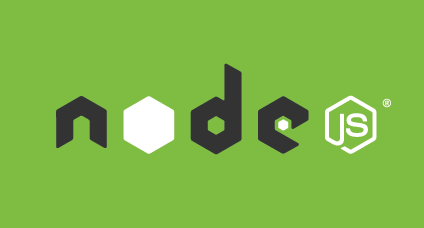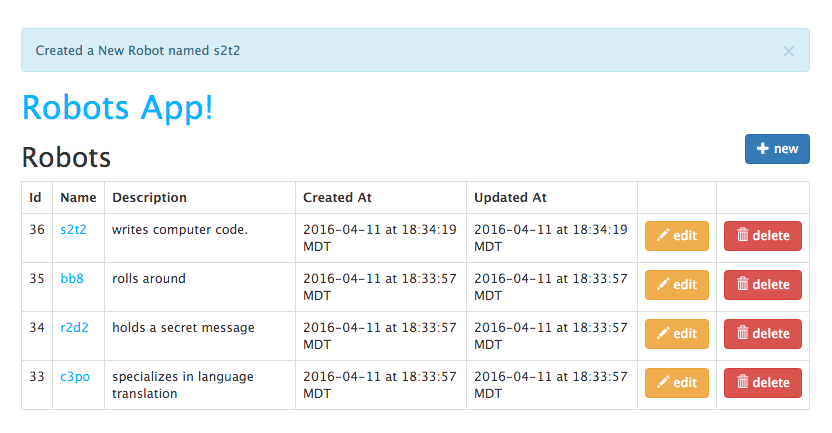
Node.js for Rails developers, Part 6a (PostgreSQL Datastore)
Published: 2016-04-09
By: MJ Rossetti

Published: 2016-04-09
By: MJ Rossetti
This post is part of a series for Rails developers who want to get started with Node.js. After enabling basic navigation, it’s time to enable database functionality. This post describes the process of connecting the application to a PostgreSQL database.
Follow these instructions to install PostgreSQL on your local machine using Homebrew, if necessary. Many Rails developers should already have PostgreSQL installed.
Create a new database user called robot and grant superuser privileges.
psql
CREATE USER robot WITH ENCRYPTED PASSWORD 'r0b0t!';
ALTER USER robot CREATEDB;
ALTER USER robot WITH SUPERUSER;
\q
Rails developers should be familiar with a db/ directory which contains database-related scripts, including migrations. We’ll adopt these same conventions in our application.
mkdir -p db/
mkdir -p db/migrations/
mkdir -p db/seeds/
touch db/create.sql
Edit db/create.sql according to the following template:
-- db/create.sql
DROP DATABASE IF EXISTS robots_dev;
CREATE DATABASE robots_dev;
GRANT ALL PRIVILEGES ON DATABASE robots_dev to robot;
Run the database creation script. Rails developers can think of this as replacing the rake db:create command.
psql -U robot --password -d postgres -f $(pwd)/db/create.sql
At this point, you should be able to login to PostgreSQL to confirm existence of a database called robots_dev.
To interface with PostgreSQL, we’ll use the PG module. We’ll also use the Knex module to run migrations and execute queries. Rails developers can think of Knex as being similar to ActiveRecord but should note Knex does not include Object-Relational Mapping (ORM) capabilities like ActiveRecord does. This means there are no models with Knex.
npm install pg --save
npm install knex --save
npm install knex -g
Initialize a new database configuration file.
knex init .
mv knexfile.js db/config.js
touch db.js
Use the file templates below to configure the database connection.
// db.js
var config = require('./db/config');
var env = process.env.NODE_ENV || 'development';
var knex = require('knex')(config[env]);
module.exports = knex;
// db/config.js (formerly known as knexfile.js
module.exports = {
development: {
client: 'pg',
connection: {
user: 'robot',
password: 'r0b0t!',
database: 'robots_dev'
},
migrations: {
directory: __dirname+"/migrations"
},
seeds: {
directory: __dirname+"/seeds"
}
},
production: {
client: 'pg',
connection: process.env.DATABASE_URL,
migrations: {
directory: __dirname+"/migrations"
},
seeds: {
directory: __dirname+"/seeds"
}
}
};
It’s time to specify the database schema. For this application, we only need one table, called robots. Use Knex to generate a new table migration called create_robots.
knex migrate:make create_robots --knexfile db/config.js
This command creates a file named something like db/migrations/20160410205446_create_robots.js.
Edit this migration file according to the following template:
// db/migrations/20160410205446_create_robots.js (NOTE: your timestamp will differ)
exports.up = function(knex, Promise) {
return Promise.all([
knex.schema.createTable("robots", function (table) {
table.increments(); // auto-incrementing integer id
table.string("name").notNullable().unique();
table.text("description").notNullable();
table.timestamp("created_at").defaultTo(knex.raw('now()')).notNullable();
table.timestamp("updated_at").defaultTo(knex.raw('now()')).notNullable();
// table.timestamps(); // creates created_at and updated_at attributes, but with no logic ...
})
]);
};
exports.down = function(knex, Promise) {
return Promise.all([
knex.schema.dropTable("robots")
]);
};
Run migrations. Rails developers can think of this as replacing the rake db:migrate command.
knex migrate:latest --knexfile db/config.js
At this point, you should be able to login to PostgreSQL to confirm existence of a table in the robots_dev database called robots.
Create a new script which will populate the robots table with example records.
touch db/seeds/insert_robots.js
Edit db/seeds/insert_robots.js according to the following template:
// db/seeds/insert_robots.js
exports.seed = function(knex, Promise) {
var robotPromises = [];
var robots = [
{name:"c3po", description:"specializes in language translation"},
{name:"r2d2", description:"holds a secret message"},
{name:"bb8", description:"rolls around"}
];
// destroy all records in the table...
var destruction_promise = knex('robots').del()
robotPromises.push(destruction_promise);
// add a new record for each robot...
var insertion_promise = knex('robots').insert(
robots, 'id' // auto-increment the id instead of setting it
);
robotPromises.push(insertion_promise);
return Promise.all(robotPromises);
};
NOTE: A Promise represents the result of an asynchronous operation.
Run the database-seeding script.
knex seed:run --knexfile db/config.js
At this point, you should be able to login to PostgreSQL to confirm existence of three records in the robots table.
We want the application to display robots from the database, not from a hard-coded variable. We also want to be able to use our views to add, edit, and delete robots from the database. Let’s connect our robots controller actions to the database.
Modify app/controllers/robots_controller.js according to the following template:
var express = require('express');
var router = express.Router();
var knex = require("../../db");
var create_robot_path = '/robots/';
function updateRobotPath(robot_id){
return '/robots/'+robot_id+'/update';
};
/* INDEX */
router.get('/robots', function(req, res, next) {
knex("robots")
.orderBy('id', 'desc')
.then(function(bots){
console.log("LIST", bots.length, "ROBOTS:", bots)
res.render('robots/index', {
page_title: 'Robots',
robots: bots
});
});
});
/* CREATE */
router.post('/robots', function(req, res, next) {
console.log("CAPTURING FORM DATA:", req.body)
var robot_name = req.body.robotName;
var robot_description = req.body.robotDescription;
if (!robot_name || !robot_description) {
console.log("DETECTED BLANK (BUT NOT NULL) ATTRIBUTE VALUES")
if (!robot_name) {
req.flash('danger', "Robot name can't be blank. Please revise and re-submit.")
}
if (!robot_description) {
req.flash('danger', "Robot description can't be blank. Please revise and re-submit.")
}
res.render('robots/new', {
page_title: 'Add a new Robot',
form_action: create_robot_path,
robot: {name: robot_name, description: robot_description} // pass-back attempted values to the form in case one was not blank
});
} else {
knex('robots')
.where({name: robot_name}) // look-up robot by unique name
.then(function(bots){
if (bots.length > 0) {
var bot = bots[0];
console.log(bot)
req.flash('danger', 'Found an Existing Robot named '+robot_name );
res.render('robots/new', {
page_title: 'Add a new Robot',
form_action: create_robot_path,
robot: {name: robot_name, description: robot_description} // pass-back attempted values to the form in case one was not blank
});
} else {
knex('robots')
.insert([{'name': robot_name, 'description': robot_description}], 'id')
.then(function(bot_id){
console.log(bot_id)
req.flash('info', 'Created a New Robot named '+robot_name );
res.redirect('/robots')
});
}
});
}
});
/* NEW */
// this must come above the SHOW action else express will think the word 'new' is the :id
router.get('/robots/new', function(req, res, next) {
console.log("NEW ROBOT")
res.render('robots/new', {
page_title: 'Add a new Robot',
form_action: create_robot_path
});
});
/* SHOW */
router.get('/robots/:id', function(req, res, next) {
var robot_id = req.params.id;
knex("robots")
.where({id: robot_id})
.then(function(bots){
if (bots.length > 0) {
var bot = bots[0];
console.log("SHOW ROBOT:", bot);
res.render('robots/show', {
page_title: 'Robot #'+bot.id,
robot: bot
});
} else {
console.log("COULDN'T SHOW ROBOT #"+robot_id);
req.flash('danger', "Couldn't find Robot #"+robot_id);
res.redirect('/robots');
}
});
});
/* EDIT */
router.get('/robots/:id/edit', function(req, res, next) {
var robot_id = req.params.id;
knex("robots")
.where({id: robot_id})
.then(function(bots){
if (bots.length > 0) {
var bot = bots[0];
console.log("EDIT ROBOT:", bot);
res.render('robots/edit', {
page_title: 'Edit Robot #'+bot.id,
robot: bot,
form_action: updateRobotPath(bot.id)
});
} else {
console.log("COULDN'T FIND ROBOT #"+robot_id);
req.flash('danger', "Couldn't find Robot #"+robot_id);
res.redirect('/robots');
}
});
});
/* UPDATE */
router.post('/robots/:id/update', function(req, res, next) {
console.log("CATURED FORM DATA", req.body)
var robot_id = req.params.id;
var robot_name = req.body.robotName;
var robot_description = req.body.robotDescription;
if (!robot_name || !robot_description) {
console.log("DETECTED BLANK (BUT NOT NULL) ATTRIBUTE VALUES")
if (!robot_name) {
req.flash('danger', "Robot name can't be blank. Please revise and re-submit.")
}
if (!robot_description) {
req.flash('danger', "Robot description can't be blank. Please revise and re-submit.")
}
res.render('robots/edit', {
page_title: 'Edit Robot #'+robot_id,
form_action: updateRobotPath(robot_id),
robot: {name: robot_name, description: robot_description} // pass-back attempted values to the form in case one was not blank
});
} else {
knex('robots')
.where({id: robot_id})
.update({name: robot_name, description: robot_description})
.then(function(number_of_affected_rows){
console.log("UPDATED", number_of_affected_rows, "ROBOT")
req.flash('success', 'Updated Robot #'+robot_id );
res.redirect('/robots')
});
}
});
/* DESTROY */
router.post('/robots/:id/destroy', function(req, res, next) {
var robot_id = req.params.id
knex("robots")
.where({id: robot_id})
.del()
.then(function(number_of_affected_rows){
console.log("DELETED", number_of_affected_rows, "ROBOT")
req.flash('success', 'Deleted Robot #'+robot_id );
res.redirect('/robots')
});
});
module.exports = router;
NOTE: In Knex and other promise-based modules, the
.then()method specifies a block of code to be executed after the query has been executed asynchronously.
At this point you should be able to use the front-end interface to create, read, update, and display robots.

Nice job. After a few more steps, we’ll be ready to push this application to production.